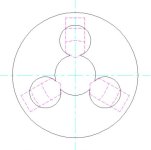JonathanK
New member
I have an Import 4 jaw chuck that came with my lathe, when I dial in work with the indicator close to the chuck I get runout when I move my indicator out from the chuck(.001 .002 TIR when indicating 3 inches from the chuck. I isolated the high spot to being one of the jaws, when I move that jaw to a different position the high spot would follow. I decided to true the jaws to the axis of the machine with a boring bar and I have a plan that I think will work. I pushed a piece of 1.5" stock in to the spindle to where only the back .200 of the jaw are gripping it, I then dialed in the chuck using a DTI on the inside of the jaws. Next I ran the DTI inward towards the spindle to make sure I wasnt binding the jaws by only gripping with the very back portion. This setup keeps a load on all 4 jaws and allows me access to bore the jaws, I could later grind the .200 below my boring. This seems to require a very rigid setup as it is hardened steel and interupted cuts. I know the chuck is cheap and I have a good 3 jaw 6" Set-Tru on the way, but I still want to see if I can make this one work the way it should. I was wondering if anyone else has came across this issue and how they fixed it. Also advice on cutting this interupted hardened material would be great.
Thanks
Jonathan K
Thanks
Jonathan K


